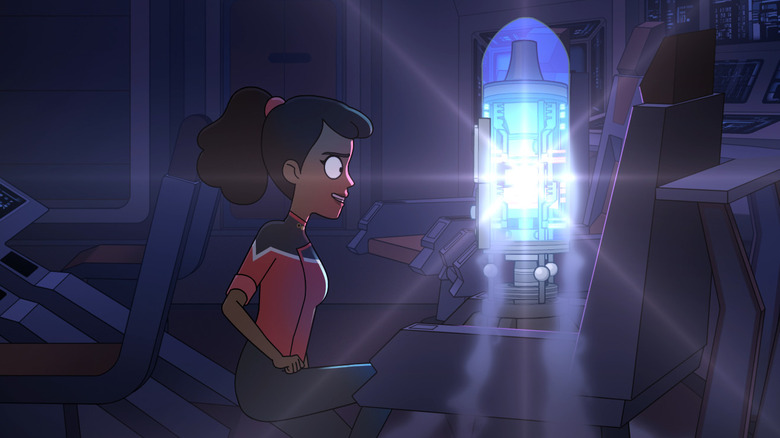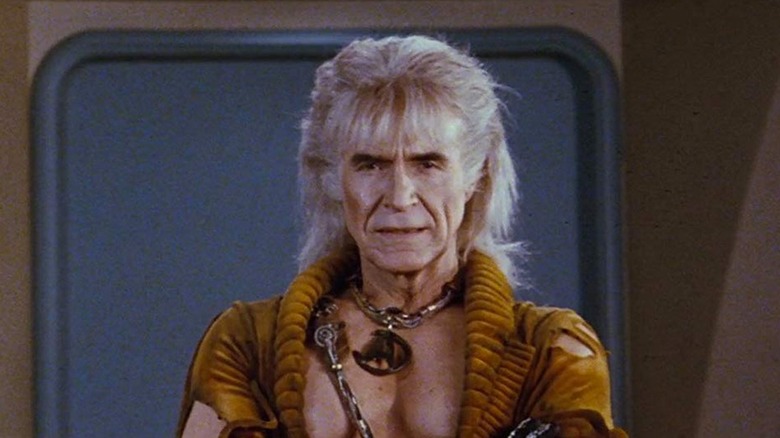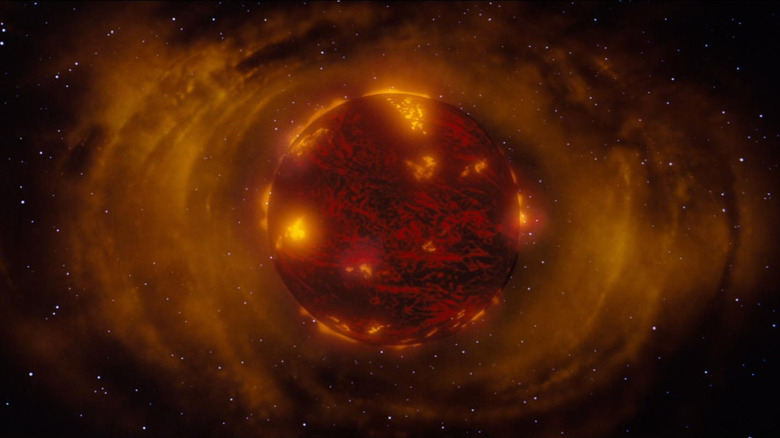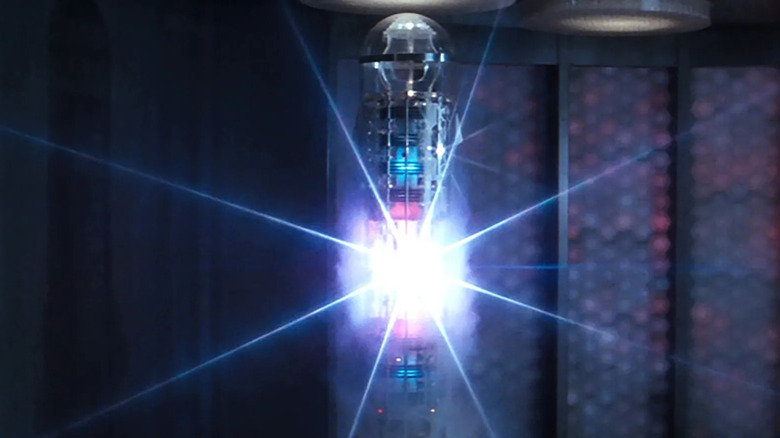Star Trek's Most Ironic Weapon: The Genesis Device Explained
Here's a fun piece of trivia: when Dr. Carol Marcus (Bibi Besch) proposes the Genesis Device in her proposal video in "Star Trek II: The Wrath of Khan," is it accompanied by an animated simulation showing a dead moon being magically terraformed within a matter of seconds. The animated simulation, rendered by Industrial Light and Magic, was the first instance of a fully rendered CGI sequence in a feature film. According to the October 1982 issue of American Cinematographer Magazine, the Genesis simulation was originally envisioned as a more traditionally realized sequence wherein a character turns a rock into a flower. Special effects supervisor Jim Veilleux felt that something more impressive was required to capture the scope of the Genesis Device's power, and the CGI sequence was developed instead.
The Genesis Device is one of the more magical objects to have emerged from "Star Trek." Introduced in "Star Trek II," it operates like a combination nuclear bomb and food replicator. The device can be fired at a lifeless planet, causing a massive explosion and reducing the entire planet's surface to subatomic particles. A specially programmed reconfiguration wave would then rebuild the destroyed surface into breathable air, mountains, trees, and all the other features typically found on inhabitable Class-M planets. Creating new life-sustaining planets would be a boon for the Federation, allowing them to colonize more worlds and instantaneously create more natural resources out of thin air.
Several characters in "Star Trek II," however, note that the Genesis Device is essentially a weapon of mass destruction. If it was fired at an inhabited world, all life on its surface would be wiped out in the terraforming process. It could conceivably destroy more life than it creates.
He tasks me
Naturally, when the vengeance-bent Khan (Ricardo Montalbán) steals the Genesis Device for himself, it's a moment of panic for Admiral Kirk (William Shatner). Khan doesn't say he has any sort of doomsday plan for the Genesis Device, but it's likely he'll try using it on Ceti Alpha V, the planet he was abandoned on after the events of the original "Star Trek" episode, "Space Seed" (February 16, 1967). Khan moved onto a remote, uninhabited planet with some compatriots, hoping to start a new master society. An environmental cataclysm, however, reduced Ceti Alpha V to a near-uninhabitable desert world. It's logical to assume that Khan would have restarted his own planet, but it was just as safe to assume that he could fly the device to Earth and wipe out the population on a whim. That Khan was unpredictable.
Indeed, during the climax of "Star Trek II," he activated the Device for use as a weapon. The device exploded while on board the U.S.S. Reliant and reconfigured the ship and the matter inside the Kutara nebula into a new planet. It seems that the Genesis Device doesn't just reconfigure the surface of a planet, but creates planets wholecloth. In "Star Trek III: The Search for Spock," however, it will be revealed that the Genesis radiation is unstable, and the newly created planet begins to break down and destroy itself. It was posited in a four-book series of "Star Trek" tie-in novels by John Vornholt called "The Genesis Wave" that the reason the Genesis planet was unstable was because it formed from a nebula and not a planet's surface like intended.
A Genesis Device wouldn't be mentioned again until the events of "Star Trek: Lower Decks" a century later.
Backward engineering
When making "Star Trek III: The Search for Spock," the filmmakers found they suddenly had a lot of questions to answer about the Genesis Device, and screenwriter Harve Bennett once revealed what a creative conundrum the Device posed to him. In the book "The Fifty-Year Mission: The Complete, Uncensored, Unauthorized Oral History of Star Trek: The First 25 Years," edited by Michael A. Altman and Edward Gross, Bennett noted that nitpicking Trekkies would likely want some questions answered about Genesis. He said:
"If you end a film with a Genesis Device that can, in one poof create life where there was lifelessness, you have created an enormous story device that cannot be ignored. Now, the fans would be justified in saying, 'Well, why not just create a planet as a plot solution?' Or, 'What would happen if the Klingons got hold of this? They wouldn't use it to make a planet, they would destroy a planet.'"
Bennett knew he had to, then, erase the Genesis Device as a Plot Device. It was too grand a technology to be a regular feature of "Star Trek." He continued:
"Therefore, the final puzzle solving was the denial of the validity of the Genesis Device. That was — 'as the Lord giveth, the Lord taketh away' — necessary or we would have expanded the borders of 'Star Trek,' even subliminally, that it would have had the same impact the A-bomb had on the 20th century, so as to make conventional things no longer viable. That's fine, but who needs to restructure 'Star Trek' on that basis?"
Hence, the Genesis Planet breaking down. Instant terraforming is too powerful to address.
It would be like, say, not addressing ship teleportation technology in a meaningful way.
The Ferengi Genesis Device
"Star Trek" is typically analytical and cautious about its technology. Not suspicious, mind you — "Trek" embraces scientific advances — but healthily wary. If a new technology is introduced into the world of "Star Trek," the beautiful eggheads and diplomats of the 23rd and 24th centuries immediately question whether it can be weaponized. If it can, then the technology needs to be more carefully developed. The Genesis Device can helpfully terraform planets, but it can also erase a planet's population. It's a Genesis Device, but also, in essence, a Revelation Device. The Alpha and the Omega simultaneously.
In the events of the "Lower Decks" episode, "Old Friend, New Planets" (November 2, 2023), it is revealed that Nick Locarno (Robert Duncan McNeill) has come into possession of a new Genesis Device. Although it's century-old technology and was developed by the Ferengi and not the Federation, the new Genesis Device looks pretty much the same as the one from "Star Trek II." Locarno, unlike Khan, had a stated intention for his Genesis Device; he aimed to create a new planet — out of the dead world Detrion IX — where the galaxy's malcontents, the ones sick of their respective unified homeworlds, could live in isolation. The planet was to be called Locarno. Perhaps predictably, Locarno's plan to create Planet Locarno was not pulled off.
It's notable that the Ferengi, however, are a profit-minded species who frequently work in the black market. Harve Bennett may have limited the scope of the Genesis Device, but that wouldn't stop some bad actors from developing their own. Luckily, the Ferengi Device doesn't do any meaningful harm.



